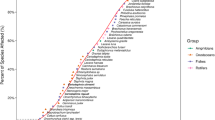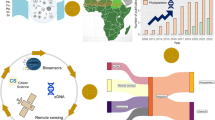Abstract
Methylmercury (MeHg) levels in dragonfly larvae and water were measured over two years in aquatic systems impacted to varying degrees by sulfate releases related to iron mining activity. This study examined the impact of elevated sulfate loads on MeHg concentrations and tested the use of MeHg in dragonfly larvae as an indicator of MeHg levels in a range of aquatic systems including 16 river/stream sites and two lakes. MeHg concentrations in aeshnid dragonfly larvae were positively correlated (R 2 = 0.46, p < 0.01) to peak MeHg concentrations in the dissolved phase for the combined years of 2012 and 2013. This relation was strong in 2012 (R 2 = 0.85, p < 0.01), but showed no correlation in 2013 (R 2 = 0.02, p > 0.05). MeHg in dragonfly larvae were not elevated at the highest sulfate sites, but rather the reverse was generally observed. Record rainfall events in 2012 and above average rainfall in 2013 likely delivered the majority of Hg and MeHg to these systems via interflow and activated groundwater flow through reduced sediments. As a result, the impacts of elevated sulfate releases due to mining activities were not apparent in these systems where little of the sulfate is reduced. Lower bioaccumulation factors for MeHg in aeshnid dragonfly larvae were observed with increasing dissolved organic carbon (DOC) concentrations. This finding is consistent with previous studies showing that MeHg in high DOC systems is less bioavailable; an equilibrium model shows that more MeHg being associated with DOC rather than algae at the base of the food chain readily explains the lower bioaccumulation factors.






Similar content being viewed by others
References
Aiken GR, Hsu-Kim H, Ryan JN (2011) Influence of dissolved organic matter on the environmental fate of metals, nanoparticles, and colloids. Environ Sci Technol 45:3196–3201. doi:10.1021/es103992s
Bailey L, Johnson N, Mitchell C, Engstrom D, Coleman-Wasik J, Berndt M (2014a) Geochemical factors influencing methylmercury production and partitioning in sulfate-impacted lake sediments. Minnesota Department of Natual Resources. 63 pp
Bailey L, Johnson N, Mitchell C, Engstrom D, Coleman-Wasik J, Kelly M, Berndt M (2014b) Seasonal and spatial variations in methylmercury in the water column of sulfate-impacted lakes. Minnesota Department of Natural Resources. 64 pp
Balogh SJ, Swain EB, Nollet YH (2008) Characteristics of mercury speciation in Minnesota rivers and streams. Environ Pollut 154:3–11. doi:10.1016/j.envpol.2007.11.014
Benoit JM, Gilmour CC, Mason RP, Heyes A (1999) Sulfide controls on mercury speciation and bioavailability in sediment pore waters. Environ Sci Technol 33:951–957
Berndt M, Bavin T (2011) Sulfate and mercury cycling in five wetlands and a lake receiving sulfate from taconite mines in Northeastern Minnesota. Minnesota DNR. 77 pp
Berndt ME, Bavin TK (2012) Methylmercury and dissolved organic carbon relationships in a wetland-rich watershed impacted by elevated sulfate from mining. Environ Pollut 161:321–327. doi:10.1016/j.envpol.2011.06.006
Bloom N (1989) Determination of picogram levels of methylmercury by aqueous phase ethylation, followd by cryogenic gas chromatography with cold vapour atomic fluorescence detection. Can J Fish Aquat Sci 46:1131–1140
Branfireun BA, Roulet NT, Kelly CA, Rudd JWM (1999) In situ sulphate stimulation of mercury methylation in a boreal peatland: toward a link between acid rain and methylmercury contamination in remote environments. Glob Geochem Cycles 13:743–750
Buckland-Nicks A, Hillier KN, Avery TS, O’Driscoll NJ (2014) Mercury bioaccumulation in dragonflies (Odonata: Anisoptera): examination of life stages and body regions. Environ Toxicol Chem 33:2047–2054. doi:10.1002/etc.2653
Burns D, Aiken G, Bradley P, Journey C, Schelker J (2013) Specific ultra-violet absorbance as an indicator of mercury sources in an Adirondack River basin. Biogeochemistry 113:451–466. doi:10.1007/s10533-012-9773-5
Carrasco L, Diez S, Soto DX, Catalan J, Bayona JM (2008) Assessment of mercury and methylmercury pollution with zebra mussel (Dreissena polymorpha) in the Ebro River (NE Spain) impacted by industrial hazardous dumps. Sci Total Environ 407:178–184. doi:10.1016/j.scitotenv.2008.07.031
Chiasson-Gould SA, Blais JM, Poulain AJ (2014) Dissolved organic matter kinetically controls mercury bioavailability to bacteria. Environ Sci Technol 48:3153–3161. doi:10.1021/es4038484
Cristol DA, Brasso RL, Condon AM, Fovargue RE, Friedman SL, Hallinger KK, Monroe AP, White AE (2008) The movement of aquatic mercury through terrestrial food webs. Science 320:335
Dittman JA, Shanley JB, Driscoll CT, Aiken GR, Chalmers AT, Towse JE (2009) Ultraviolet absorbance as a proxy for total dissolved mercury in streams. Environ Pollut 157:1953–1956. doi:10.1016/j.envpol.2009.01.031
Dittman JA, Shanley JB, Driscoll CT, Aiken GR, Chalmers AT, Towse JE, Selvendiran P (2010) Mercury dynamics in relation to dissolved organic carbon concentration and quality during high flow events in three northeastern U.S. streams. Water Resour Res 46:W07522. doi:10.1029/2009WR008351
Evers DC, Taylor KM, Major A, Taylor RJ, Poppenga RH, Scheuhammer AM (2003) Common loon eggs as indicators of methylmercury availability in North America. Ecotoxicology 12:69–81
Fitzgerald WF, Gill GA (1979) Subnanogram determination of mercury by two-stage gold amalgamation and gas phase detection applied to atmospheric analysis. Anal Chem 51:1714–1720. doi:10.1021/ac50047a030
French TD, Houben AJ, Desforges J-PW, Kimpe LE, Kokelj SV, Poulain AJ, Smol JP, Wang X, Blais JM (2014) Dissolved organic carbon thresholds affect mercury bioaccumulation in Arctic lakes. Environ Sci Technol 48:3162–3168. doi:10.1021/es403849d
Gilmour C, Henry E (1991) Mercury methylation in aquatic systems affected by acid deposition. Environ Pollut 71:131–169
Gilmour C, Riedel G, Ederington M, Bell J, Benoit J, Gill G, Stordal M (1998) Methylmercury concentrations and production rates across a trophic gradient in the northern Everglades. Biogeochemistry 40:327–345
Gilmour CC, Elias DA, Kucken AM, Brown SD, Palumbo AV, Schadt CW, Wall JD (2011) Sulfate-reducing bacterium Desulfovibrio desulfuricans ND132 as a model for understanding bacterial mercury methylation. Appl Environ Microbiol 77:3938–3951. doi:10.1128/aem.02993-10
Graham AM, Bullock AL, Maizel AC, Elias DA, Gilmour CC (2012) Detailed assessment of the kinetics of Hg-cell association, Hg methylation, and methylmercury degradation in several Desulfovibrio species. Appl Environ Microbiol 78:7337–7346. doi:10.1128/aem.01792-12
Graham AM, Aiken GR, Gilmour CC (2013) Effect of dissolved organic matter source and character on microbial Hg methylation in Hg-S-DOM solutions. Environ Sci Technol 47:5746–5754. doi:10.1021/es400414a
Hall BD, Cherewyk KA, Paterson MJ, Bodaly RA (2009) Changes in methyl mercury concentrations in zooplankton from four experimental reservoirs with differing amounts of carbon in the flooded catchments. Can J Fish Aquat Sci 66:1910–1919. doi:10.1139/f09-123
Hammerschmidt CR, Fitzgerald WF (2008) Methylmercury in arctic Alaskan mosquitoes: implications for impact of atmospheric mercury depletion events. Environ Chem 5:127–130. doi:10.1071/en08003
Hammerschmidt CR, Fitzgerald WF (2010) Iron-mediated photochemical decomposition of methylmercury in an Arctic Alaskan lake. Environ Sci Technol 44:6138–6143. doi:10.1021/es1006934
Haraguchi K, Ando T, Sato M, Kawaguchi C, Tomiyasu T, Horvat M, Akagi H (2000) Detection of localized methylmercury contamination by use of the mussel adductor muscle in Minamata Bay and Kagoshima Bay, Japan. Sci Total Environ 261:75–89. doi:10.1016/s0048-9697(00)00626-4
Haro RJ, Bailey SW, Northwick RM, Rolfhus KR, Sandheinrich MB, Wiener JG (2013) Burrowing dragonfly larvae as biosentinels of methylmercury in freshwater food webs. Environ Sci Technol 47:8148–8156. doi:10.1021/es401027m
Hintelmann H, Evans R (1997) Application of stable isotopes in environmental tracer studies—measurement of monomethylmercury (CH3Hg+) by isotope dilution ICP-MS and detection of species transformation. Fresenius J Anal Chem 358:378–385
Hsu-Kim H, Kucharzyk KH, Zhang T, Deshusses MA (2013) Mechanisms regulating mercury bioavailability for methylating microorganisms in the aquatic environment: a critical review. Environ Sci Technol 47:2441–2456. doi:10.1021/es304370g
Jeremiason JD, Engstrom DR, Swain EB, Nater EA, Johnson BM, Almendinger JE, Monson BA, Kolka RK (2006) Sulfate addition increases methylmercury production in an experimental wetland. Environ Sci Technol 40:3800–3806
Karlsson T, Skyllberg U (2003) Bonding of ppb levels of methyl mercury to reduced sulfur groups in soil organic matter. Environ Sci Technol 37:4912–4918. doi:10.1021/es034302n
Khwaja AR, Bloom PR, Brezonik PL (2010) Binding strength of methylmercury to aquatic NOM. Environ Sci Technol 44:6151–6156. doi:10.1021/es101088k
Kidd K, Clayden M, Jardine T (2012) Bioaccumulation and biomagnification of mercury through food webs. In: Liu G, Cai Y, O’Driscoll N (eds) Environmental toxicology and chemistry of mercury, 1st edn. Wiley, Hoboken, pp 455–499
Needham JG, Westfall MJ Jr, May ML (2000) Dragonflies of North America. Revised edn. Scientific Publications, Gainesville
Omernik JM, Gallant AL (1988) Ecoregions of the upper midwest states. U.S. Environmental Protection Agency. Environmental Research Lab, Corvallis 56 pp
Poulin BA, Ryan JN, Aiken GR (2014) Effects of iron on optical properties of dissolved organic matter. Environ Sci Technol 48:10098–10106. doi:10.1021/es502670r
Rolfhus KR, Wiener JG, Haro RJ, Sandheinrich MB, Bailey SW, Seitz BR (2015) Mercury in streams at grand portage national monument (Minnesota, USA): assessment of ecosystem sensitivity and ecological risk. Sci Total Environ 514:192–201. doi:10.1016/j.scitotenv.2015.01.079
Scheuhammer AM, Meyer MW, Sandheinrich MB, Murray MW (2007) Effects of environmental methylmercury on the health of wild birds, mammals, and fish. Ambio 36:12–18
Sellers P, Kelly CA, Rudd J, MacHutchon A (1996) Photodegradation of methylmercury in lakes. Nature 380:694–697
Tetratech (2015) St. Louis, Cloquet, and Nemadji River basins—phase II, hydrology and sediment model calibration. Minnesota Pollution Control Agency. 275 pp
Tremblay A, Lucotte M (1997) Accumulation of total mercury and methyl mercury in insect larvae of hydroelectric reservoirs. Can J Fish Aquat Sci 54:832–841
Tremblay A, Lucotte M, Meili M, Cloutier L, Pichet P (1996) Total mercury and methylmercury contents of insects from boreal lakes: ecological, spatial and temporal patterns. Water Qual Res J Can 31:851–873
Tsui MTK, Finlay JC (2011) Influence of dissolved organic carbon on methylmercury bioavailability across Minnesota stream ecosystems. Environ Sci Technol 45:5981–5987. doi:10.1021/es200332f
Vander Zanden MJ, Rasmussen JB (1999) Primary consumer delta C-13 and delta N-15 and the trophic position of aquatic consumers. Ecology 80:1395–1404
Wallace FB, Anderson NH (1995) Habitat, life history, and behavioral adaptations of aquatic insects. In: Merritt RW, Cummins KW (eds) An Introduction to the aquatic insects of North America, 3rd edn. Kendall/Hunt Publishing Company, Dubuque, pp 41–75
Wiener JG, Krabbenhoft DP, Heinz GH, Scheuhammer AM (2003) Ecotoxicology of mercury. In: Hoffman DJ, Rattner BA, Burton GA, Jr, Cairns J, Jr (eds) Handbook of ecotoxicology, 2nd edn. CRC Press, pp 409–463
Wiener JG, Knights BC, Sandheinrich MB, Jeremiason JD, Brigham ME, Engstrom DR, Woodruff LG, Cannon WF, Balogh SJ (2006) Mercury in soils, lakes, and fish in voyageurs national park (Minnesota): importance of atmospheric deposition and ecosystem factors. Environ Sci Technol 40:6261–6268
Wyman KE, Rodenhouse NL, Bank MS (2011) Mercury bioaccumulation, speciation, and influence on web structure in orb-weaving spiders from a forested watershed. Environ Toxicol Chem 30:1873–1878. doi:10.1002/etc.572
Acknowledgments
We thank Joel Carlin, Megan Kelly, Benjamin Van Korff, Will Metcalf, and Derrick Berndt for assistance with larvae collection. Griffin Reed, Nevada Wendlandt, Amy Christiansen, Russell Kruger, Will Metcalf, and Tina Dahlseid processed and assisted with analyzing the larvae. Emily Seelen, Will Metcalf, and Signe Jeremiason assisted with identifying the larvae by family. Alison Agather, Michael Walker, Benjamin Van Korff, Bryan Voigt, Anna Huff, and Nathan Olson processed and analyzed THg and MeHg water samples. Kenna Butler provided analytical assistance. Travis Bavin, Bruce Monson, and Joel Carlin provided valuable technical assistance and suggestions. Funding was provided by the Minnesota Department of Natural Resources Iron Ore Cooperative Research program, the Minnesota Department of Natural Resources Environmental Cooperative Research program, the Clean Water Fund through the Minnesota Pollution Control Agency, the National Science Foundation (Research award number 0923430), Gustavus Adolphus College, and the U. S. Geological Survey Toxics Substances Hydrology Program. Any use of trade, firm, or product names is for descriptive purposes only and does not imply endorsement by the U.S. Government.
Author information
Authors and Affiliations
Corresponding author
Ethics declarations
Conflict of interest
The authors declare that they have no conflict of interest.
Electronic supplementary material
Below is the link to the electronic supplementary material.
Rights and permissions
About this article
Cite this article
Jeremiason, J.D., Reiser, T.K., Weitz, R.A. et al. Aeshnid dragonfly larvae as bioindicators of methylmercury contamination in aquatic systems impacted by elevated sulfate loading. Ecotoxicology 25, 456–468 (2016). https://doi.org/10.1007/s10646-015-1603-9
Accepted:
Published:
Issue Date:
DOI: https://doi.org/10.1007/s10646-015-1603-9




